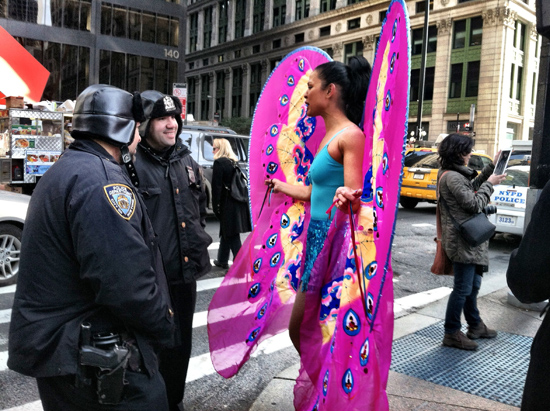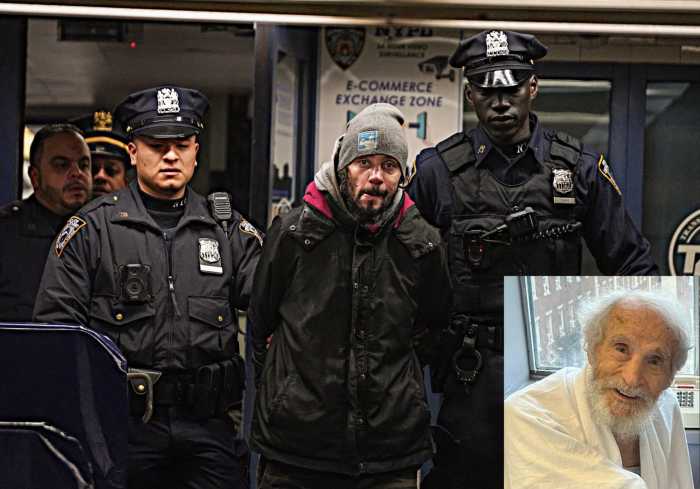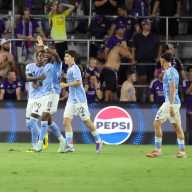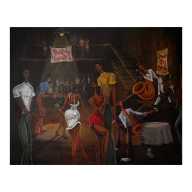BY JOHN BAYLES | This time they were ready. As Occupy Wall Street activists took to the streets on Saturday to march against police brutality, they were prepared.
“Some marches are feel-good marches,” said Marni Halasa, “but with this march in particular, there was a lot of frustration directed toward the NYPD.”
Much of Saturday’s frustration, according to Halasa, stemmed from current events, specifically the shooting of Trayvon Martin, a teenager that was gunned down in Florida two weeks ago, as well as the recent ruling in the Sean Bell case, which, for New Yorkers, goes back five and half years.
But as for O.W.S., the march on Saturday had as much to do with those specific cases as with the ever-increasing police-harassment that many protesters believe is a direct attempt to stem what the movement has promoted as the upcoming “American Spring.”
While for the last three months O.W.S. has, to a certain degree, been operating behind the scenes, with the warmer weather has come an increased amount of activity. Many members of the movement have been taking part in exercises directed toward non-violent protest protocol. With marches and rallies planned for every Friday between now and the movement’s May Day general strike, the activists are preparing for what they have deemed the “American Spring.”
On Friday in Zuccotti Park, numerous O.W.S. activists practiced what they have come to call a “die-in,” where protesters simply fall to the ground when confronted by police and remain still, essentially forcing the police to pick them up and carry them away.
On Saturday at roughly 1:30 p.m. the tactic was employed at the corner of Lafayette and Canal Streets. At least two demonstrators were arrested when they fell down in the middle of the street and the NYPD forcibly removed them and placed them in handcuffs.
The march, which Halasa called “celebratory” and “non-aggressive,” was in her experience the most over-policed march she has witnessed since the beginning of the movement over six months ago.
“The march on Saturday was upbeat,” said Halasa. “The police [presence] was a direct response to the fact that it was against police brutality.”
Kevin Jones, 57, from Brooklyn echoed Halasa.
“The march was aggressively over policed,” said Jones.
A veteran of sorts, Jones has been involved with O.W.S. since the movement’s infancy. He’s been a part of numerous O.W.S. marches, but on Saturday he described what he saw as an overt effort on the part of the NYPD to “exert its influence on the movement.”
“[There was a] concerted effort to prepare on the part of the protesters, and an equal effort on the part of the NYPD to crush this,” said Jones. “They’re trying to scare anyone involved. They’re saying if you do participate, then you have a good chance of being arrested or injured.”
Jones added that he was holding a sign on Saturday in Union Square that read, “Dissent is not a crime.”
“A police officer came up to me and told me that dissent is not a crime, but it is a violation,” said Jones.

Halasa also has her own story of the evolving role of the police in the last few months. On Saturday, March 8, Halasa was taking part in the “Women’s Independence” march when she was issued a summons for impeding pedestrian traffic.
Halasa has come to be known as the O.W.S. Butterfly. She wears a costume consisting of colorful wings and a flowing skirt and rollerblades around Zuccotti Park during the protests.
On a day when the number of protesters was minimal compared to other marches, Halasa was approached by two NYPD officers that told her she was clear to skate around so long as she “didn’t get in the way” of traffic. Halasa, a professional skater, made her usual rounds, skating around the perimeter of the park until she was abruptly stopped by NYPD officers and was issued a summons.
Halasa said a member of the New York chapter of the National Lawyers Guild told her the situation wreaked of “entrapment.” The “O.W.S. Butterfly” now has to appear in court in May. An attorney from the National Lawyers Guild will represent her and she plans to wear her costume to court. But Halasa’s costume is a message in itself.
“What I’m trying to do is help spread the word and make the [movement’s] message more accessible,” said Halasa. “What I do is add a sense of humor to the movement, especially when things get tense. What’s more important than what I look like is what is coming out of my mouth.”





























